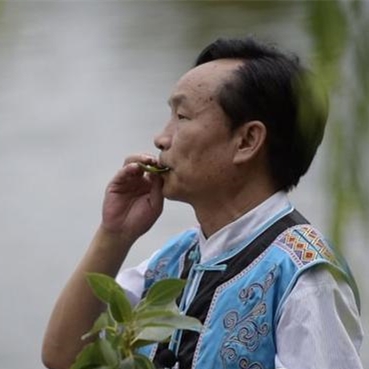Luo Wenjun
Organized by 尘夕 on 2022-03-07

Luo Wenjun, born in August 1960, graduated from the Guizhou Provincial Art College in 1982, and was admitted to the Guizhou Provincial National Song and Dance Troupe in May 1986.
Luo Wenjun has been engaged in stage performance and teaching of national musical instruments such as Konoha, Bamboo Flute, Bawu, Hulusi and Lusheng. ", "Love in Yi Mountain", etc. have been broadcast on CCTV and China National Radio, and the Oriental Time and Space column has made a special report, hailing Luo Wenjun's Konoha playing as "one of the best in China".
Over the years, Luo Wenjun has gone to the United States, Canada, France, Poland, Switzerland, Hong Kong and other countries and regions to participate in more than 20 international art festivals with the Chinese Art Troupe. In European and American performances, the "Konoha Solo" program was very popular, and local radio, television, and newspapers reported it one after another, calling it "Oriental Magic Leaf" and "Magic Magic Leaf".
Luo Wenjun, who walked out of Guizhou and went to the world with a Konoha, is now a national first-class actor and a famous Konoha performer in the Guizhou Provincial National Song and Dance Troupe.
Similar artist
Ye Diyunyang, an up-master of the music area of station B, his work "Ye Fu", an online teaching of how to use leaves to play, has been played for 3.254 million times. "City in the Sky" and other musical works.
read >>
Involving musical instruments
Hulusi (pinyin: hú lu sī), also known as "calabash flute", is a musical instrument of ethnic minorities in Yunnan. Hulusi originated in Lianghe County, Dehong Dai and Jingpo Autonomous Prefecture, and is mainly popular in Dai, Achang, Wa, De'ang and Brown. The Dehong and Lincang areas in Yunnan where ethnic groups live together are rich in local colors.
Lusheng (pinyin: lú shēng) is a reed instrument of the Miao, Yao, Dong and other ethnic groups in the southwest region. Its predecessor was the yu of the Han nationality.
Konoha (pinyin: mù yè) is a musical instrument popular among many ethnic groups in ancient my country. It is a natural musical instrument of the Miao family that is rich in antiquity. Playing Konoha is an ancient folk art of the Miao people.
Bawu (pinyin: bā wū), alias Bawu, Gebi, Bai, Bilu, Ule, is a bamboo-winded and copper-reed musical instrument, popular among the Yi, Miao, Hani and other ethnic groups in Yunnan.
Dizi (pinyin: dí zi), also known as the horizontal flute, is generally used as an important musical instrument to accompany opera.
Involved portfolio
Involved news
Organized by 雨童 on 2022-03-21
Bai folk instrumental music mainly includes sanxian music, suona wind and percussion music, cave scripture music, etc. In addition, there are also ancient music and tunes played by bamboo flute, mouth spring, wood leaf and so on.
read >>
Organized by ky on 2022-03-15
The skill of wood leaf playing is one of the symbols of Tujia culture. In April 2011, the Chongqing Municipal People's Government announced the Konoha Play as the third batch of municipal intangible cultural heritage list.
read >>
Organized by ky on 2022-02-22
Konoha is the simplest and oldest musical instrument. In the hunting era of primitive society, onomatopoeia was used to hunt birds and birds, and later it was gradually transformed into an instrument that replaced music with sound and sang with sound.
read >>
Organized by 袁城 on 2022-02-22
Konoha is the simplest and oldest musical instrument. In the hunting era of primitive society, onomatopoeia was used to hunt birds and birds, and later it was gradually transformed into a musical instrument that replaced music with sound and sang with sound. For thousands of years, the rumor of blowing wood leaves has not faded, but it was found in historical records later.
read >>
Organized by 阿蘅 on 2022-02-22
Konoha is a single group of ethnic groups such as Miao, Yao, Dong, Yi, Zhuang, Buyi, Li, Tujia, Lisu, Achang, Bai, Dai, Shui, Hani, Gelao, Mulao, Maonan, Manchu, Mongolian, Tibetan and Han. Reed air instrument. In the Miao language, it is called Heibulong and Promoting the Brain. The Dong language is called Bamei and Gabuluo. In Yi language, it is called Siqie and Siqie. In Zhuang language, it is called Baimei. Widely popular in Guizhou, Sichuan, Yunnan, Hunan, Hubei, Guangxi, Fujian, Hainan, Inner Mongolia and Northeast China.
read >>

 渝公网安备 50010702504639号
渝公网安备 50010702504639号